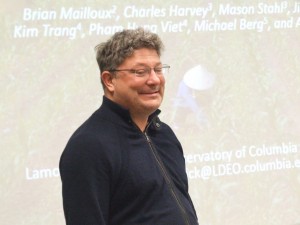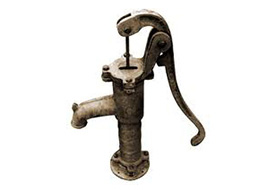The Source and Solution to Groundwater Arsenic Contamination
Guest Scientist: Benjamin Bostick

(Image credit: G. Hofer)
Originally presented: 28 Mar 2015
Abstract:
Arsenic is one of the most ubiquitous contaminants in groundwater and a major cause of disease worldwide. We will discuss reasons that specific areas have arsenic contamination, why those areas are at risk, implications of the problem, and potential engineered solutions to this problem.
Ben Bostick is a Lamont Associate Research Professor in the Geochemistry Division. He earned his Ph.D. at Stanford University, after obtaining his BS and MS degrees from the University of Idaho. His fields of study include soils, aqueous geochemistry, sediment redox cycling, biogeochemistry, mineralogy, and applications of spectroscopy in the Earth Sciences.
Dr. Bostick’s presentation:
PREVIOUS E2C WORKSHOP ON THIS TOPIC:
“Arsenic in the Groundwaters of Bangladesh” with Dr. Alexander van Geen
“Visualization of Groundwater Flow Using Sand Boxes, Links to Local and International Water Resources Issues”
with Martin Stute
RELATED LDEO RESEARCH AND NEWS STORIES:
Scientific publications pertinent to this presentation:
Van Geen, et al. (2013) Retardation of arsenic transport through a Pleistocene aquifer. Nature, 501, 204 – 207. doi: 10.1038/nature12444.

Cambodia Groundwater Quality Survey
Environmental Tracer Group of Lamont-Doherty Earth Observatory
Members of our group work on a variety of projects including studies of water movement in natural systems (ocean, groundwater), reconstruction of continental paleotemperature records using aquifers as archives, gas exchange between the atmosphere and natural water bodies, and cosmogenic 3He in sediments.
Columbia As Project (NIEHS Superfund Research Program)
Health Effects and Geochemistry of Arsenic and Manganese
The Columbia University Superfund Research Program focuses on the health effects, geochemistry, and remediation of Arsenic (As) and Manganese (Mn), primarily in groundwater. The program seeks to obtain new scientific knowledge, to provide multidisciplinary training for pre- and post-doctoral students, and to facilitate the translation of its research findings and products into effective policy applications to improve public health
Superfund Online Mapping Project
News Stories:
RELATED SCIENTIFIC RESOURCES:
Arsenic in Soil and Groundwater: An Overview
Arsenic in Groundwater: A Summary of Sources and the Biogeochemical and HydrogeologicFactors Affecting
Arsenic Occurrence and Mobility
USGS National Water Quality Assessment Program
“Arsenic in Groundwater of the United States”
“Mapping Arsenic in Groundwater”
USGS Environmental Health–Toxic Substances
“Natural Breakdown of Petroleum Results in Arsenic Mobilization in Groundwater”
USGS Water-Resources Investigation Report 03-4315
“Occurrence of Arsenic in Groundwater of Suffolk County, 1997 – 2002”
USGS Groundwater Information Pages
USGS National Water Information System Water Data for the Nation
New Jersey Geological Survey
“Arsenic in New Jersey Goundwater”
Meadowlands Environmental Research Center
CLASSROOM ACTIVITIES:
Classroom Activity: “Mathematical Modeling of Groundwater: Porosity, Permeability, and Capillarity”
Classroom Activity: “Activities about Sediments”
Climate Change Human Health: Water Resources
“There Must Be Something in the Water” — NYT Learning Blog
“Soda Bottle Hydrology” — T.W. and C. Cavanaugh
USGS Water Science for Schools
includes “Earth’s Water,” “Water Basics,” “Water Use,”
“Water Cycle” diagrams in many languages, and more
University of Wisconsin Stevens Point Student Chapter of the AWRA Groundwater Model Project
Ground Water Contamination: Trouble in Fruitvale
(SEPUP Lawrence Hall of Science)
The Groundwater Foundation Education Links
ex: “What Is Groundwater?”
“How Wet Is Our Planet?”
BBC Radio 4 “Groundwater” programme
Environment Canada Groundwater–Nature’s Hidden Treasure
Groundwater Animations (compiled by Mark Francek)
Circle of Blue Weekly Water News
Other Resources for This Topic
New York City’s Drinking Water


